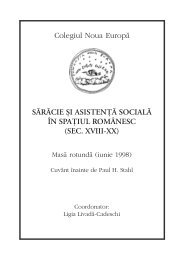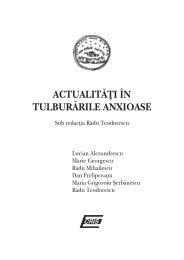New Europe College Regional Program Yearbook 2001-2002
New Europe College Regional Program Yearbook 2001-2002
New Europe College Regional Program Yearbook 2001-2002
Create successful ePaper yourself
Turn your PDF publications into a flip-book with our unique Google optimized e-Paper software.
NIKOLAI VUKOV<br />
for heroes and ordinary Christians to face […] the humiliation of death and<br />
the horror of putrefaction” (Cf. Bynum 1995:45-46).<br />
19 About the special role that the figures of heroes played in socialist culture, v.<br />
Clark 1981; Morris 1993; Unfried 1999.<br />
20 Cf. C. Lefort’s analysis of “the representation of the People-as-one”, as built<br />
on a denial that society consists of divisions. As a consequence of such<br />
policies, he claims, “In the so-called socialist world, there can be no other<br />
division than that between the people and enemies” (Lefort 1986). More<br />
about the construction of communist parties’ identities by defining and<br />
sustaining a wide array of images of enemies, cf. in K. Verdery’s interpretation<br />
of Lefort’s thesis, in Verdery 1996:93.<br />
21 V. in this respect P. Brown’s classic text about saints as exemplars in Late<br />
Antiquity (Brown 1983). Cf. also K. Verdery’s analysis of the importance of<br />
“exemplary biographies” of “remarkable men” in shaping Romanian national<br />
sentiment – just as medieval Christians absorbed the exemplary lives of<br />
saints, she points out, so 20-century Romanians learned to identify with<br />
exemplary national heroes. Cf. Verdery 1999:77. The conscious<br />
appropriation by communists of the technique of exemplars found in ancient<br />
and medieval religious traditions should not be overestimated, though clear<br />
questions of this technique in the communist persuasion after World War II<br />
in Eastern <strong>Europe</strong> may often amaze the researcher.<br />
22 About monuments to the First World War, v. esp. Fussell 1975; Descamps<br />
1978; Mosse 1990; Prost 1997; Winter 1995; Kosellek 1997; Heathcote<br />
1999: 42-47; Winter 1999; Agulhon <strong>2001</strong>:35-46, etc.<br />
23 Cf. for example, the pervading wave of monuments in all Eastern <strong>Europe</strong>an<br />
countries dedicated to rebellions and uprisings which communist ideology<br />
considered as preceding and foreshadowing its own victory.<br />
24 Cf., for example, such monuments as those in Bãleni-Sîrbi, Bujoreni, Fîntînele<br />
(1976), Focºani, Lãpuºel, Olteni, Sãlcina de Sus (1946), Scãriºoara (1980),<br />
and Valea Doftanei. An interesting example is a monument in Pãtîrlagele.<br />
Built in 1928, it was initially a monument to the heroes of the First World<br />
War, but, to the inscription “Celor ce s-au jertfit pentru patrie”, another<br />
obviously later inscription was added – “Heroes from Pãtîrlagele, who fought<br />
against German fascism, 1944-1945.”<br />
25 In Romania, for example, monuments of this “mixed” type were widely<br />
spread in the interwar period, bringing together the wars for independence<br />
and the First World War. Cf. such monuments as those in Corod (near<br />
Galaþi), Români (near Neamþ), Rugineºti (near Vrancea), Tîrgoviºte, Devesel,<br />
Vlãdeni (Dîmboviþa), Ghigoeºti, Glodeni (1938), Ianca, Vaslui (1934), Liteni<br />
(1923), Zimnicea (1930). Attention should also be drawn to cases of really<br />
wide continuity, such as the monument in Hãlmagiu, which represents a<br />
memorial ensemble dedicated to martyrs of the rebellion of 1784, to the<br />
heroes of the revolution of 1848-1849 and to the First World War.<br />
289







